Art of the Genre: Interview with Jack Crane
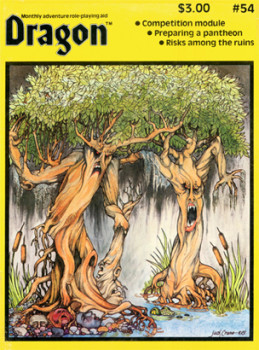 You know, sometimes your boss just refuses to let you enjoy your life… It’s no different here at Black Gate L.A. even though our intrepid editor-in-chief John O’Neill is thousands of miles away in Illinois.
You know, sometimes your boss just refuses to let you enjoy your life… It’s no different here at Black Gate L.A. even though our intrepid editor-in-chief John O’Neill is thousands of miles away in Illinois.
I mean, take this month as a perfect example. On any given day the sun is shining, my office partner Ryan Harvey is talking non-stop about the upcoming release of Captain America: The Winter Soldier and Kandi, our secretary, is whispering/weeping to her agent about her lack of a callback, but all in all life is pretty good.
Then wouldn’t you know it, I get a text from the aforementioned Mr. O’Neill to gather up my winter gear and before you can utter the words ‘polar vortex’ I’m on a flight to Pennsylvania for an interview.
Now granted, it is an interview of a lifetime, breaking bread and talking shop with legendary Dragon Magazine cover artist Jack Crane, but nonetheless couldn’t Dr. Evil himself have picked early autumn to get this copy?!
Anyway, off I went to brave the cold, first to Philadelphia and then on up the Westchester Pike to the fine and frosty town of elven thousand souls, Broomall, PA. If you’ve never been to Broomall, I wouldn’t suggest going when it is -8 degrees, but still it is a fine little piece of Americana.
With my sightseeing limited, I headed to Phil A Mignon, a nice down home pizza and burger joint to meet with Jack before going to his studio. My order, well a ‘filet cheese steak’ of course, and some highly recommended raspberry peppercorn wings. It was darn fine food, and the filet was incredible compared to the standard greasy Philly steaks.
After the meal Jack and I fell into our interview, my now wing-sauce free hands ready to take notes on all this incredible artist had to say concerning his life, art, and how it was working in the heady days of the early 1980s Dragon Magazine.
An Interview With Jack Crane
Conducted and transcribed by Scott Taylor, January 2014
BG: As there is no standing biography on you, can you give the readers a bit of your history, upbringing, and career inspiration?
JC: I grew up in a traditional middle class, blue collar family and neighborhood. None of my relatives, including either of my parents, had ever attended college. Within our family, my younger brother, one cousin, and I, were the first [and the only ones in that generation] to attend and complete higher education. My brother majored in business, my cousin in dentistry and I originally majored in science.
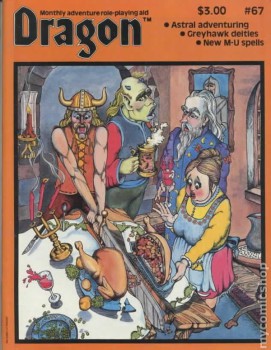 I’ve always loved art, particularly the French Impressionists, Art Nouveau School, Cubists and Surrealists. However, I never considered art as a career since my high school was very committed towards directing everyone in the academic section into math, the sciences or engineering. I had art one day a week for 45 minutes until I was in ninth grade, at which point my guidance counselors guided me into a schedule that was heavy in math and science. Upon graduation I entered a small liberal arts college as a science major with a passion for biology.
I’ve always loved art, particularly the French Impressionists, Art Nouveau School, Cubists and Surrealists. However, I never considered art as a career since my high school was very committed towards directing everyone in the academic section into math, the sciences or engineering. I had art one day a week for 45 minutes until I was in ninth grade, at which point my guidance counselors guided me into a schedule that was heavy in math and science. Upon graduation I entered a small liberal arts college as a science major with a passion for biology.
I was enrolled in college as a full-time day student while working part-time at a local department store … in their complaint department, which gave me a real appreciation for the incompetence of large corporations! At the end of the second semester of my sophomore year, I cut back my school hours to part time and increased my working hours to full time in order to earn more money for my college expenses. Upon doing so, I immediately received my Draft Notice for induction into the U. S. Army! They were absolutely obsessed with having me enlist and enroll in Officers Candidate School with an end game of me being a helicopter pilot! Since I had no desire to kill anyone, and since one out of three Hughie pilots never came home, I kept avoiding the Army enlistment officer who was hounding me. This guy even stopped by my home a couple of times and called me when I was on a trip visiting my girlfriend in NH. I’m certain that he already had plans for the bonus he would have received had he coerced me into enlisting.
I decided to enlist in the USAF after I aced all of their qualification tests and they offered me a position in Intelligence. I spent four years as an intelligence analyst during the Vietnam years, with one of those years spent in South East Asia during the Tet Offensive. Not a fun time! During those four years I also created a lot of graphics for briefings after the USAF discovered that I had art talent and I already possessed a Top Secret Crypto clearance. The art was a welcome diversion from my “real job”. They offered me outrageous bonuses to reenlist, but I wanted no part of it. I had had enough of the military.
After receiving an honorable discharge from the USAF, I originally planned on finishing my studies in biology at The University of South Florida. But I had started having second thoughts about biology as a major since most of my friends who graduated with a degree in biology were working in boring, low paying jobs, even with Master’s Degrees … except those who went to work for chemical companies or other huge corporations. I wanted no part of that either!
To be honest, I had no art career inspirations or aspirations at that point of my life.
How did you start your career as an artist?
To kill time while I contemplated my post-USAF future, I accepted a position in the electrical engineering department of a company in PA. The company loved my work but I hated the lack of creativity in my job. A coworker and good friend was taking night school courses at the Philadelphia College of Art [now known as The University of the Arts]. He convinced me into accompanying him to one of his night school classes, to which I brought some samples of my own work to show his instructors. All that I had created at that time was done in my spare time and consisted of fantasy, science fiction, portraits and a few landscapes.
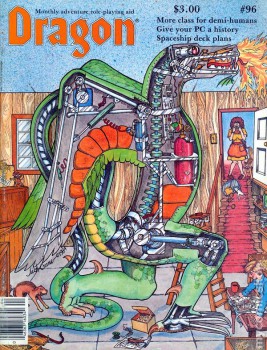 The professors at PCA encouraged me to sign up for a couple of night school classes. I figured, what the heck, the U.S. government would be paying for them as part of my GI education benefits. Over the next year, I completed four night school courses and did well in all of them. Then the same professors started encouraging me to quit my job and enroll in the full time day program.
The professors at PCA encouraged me to sign up for a couple of night school classes. I figured, what the heck, the U.S. government would be paying for them as part of my GI education benefits. Over the next year, I completed four night school courses and did well in all of them. Then the same professors started encouraging me to quit my job and enroll in the full time day program.
The boss where I was working, a terrific Japanese American guy, had two children who had majored in art and both were very successful artists. He also quietly and confidentially informed me that the company was going to shut down the entire plant and move the engineering department to The South, probably North Carolina and Florida.
The universe seemed to be channeling me towards art. Again, I figured what the heck, I was still young and the U.S. government would be paying the tuition, so I quit my job and enrolled in PCA day classes full-time. If all of this failed I could always go back into engineering or switch back to biology as a career. I saw too many of my coworkers who regretted not taking professional chances in their youth that could have resulted in them being much happier than they were in the present.
Again, I did very well at PCA, this time staying on the Dean’s List for the entire duration of my studies and winning the 1975 Illustration Department’s Senior Class Competition, which included a nice cash prize. Winning the competition gave me enough self-confidence plus the prize money to strike out as a freelance illustrator and designer.
The first few years were tough, but I loved what I was doing and had a great time. My career took me in some truly unique directions – fantasy art, science fiction art, “hard” science illustration, medical illustration, model making for legal displays, and much more. I’d found what I’d craved all along – creative challenges and something new and unexpected around every corner. I’ve never looked back!
Can you give us a bit of info about how you got your job doing covers for Dragon Magazine?
I had some highly educated Chester County friends who were avid D&D players. I started playing the game with them, creating a wizard character for myself.
In the summer of 1980 there was a Fantasy and Science Fiction convention at one of the local universities. On a whim, I decided to attend and took some samples of my artwork. Kim Mohan and several of his Dragon Magazine cohorts were there occupying a booth for TSR. We all hit it off and they ended up spending a long Saturday night with my friends and me as we hit some of the “local establishments” that offered live music.
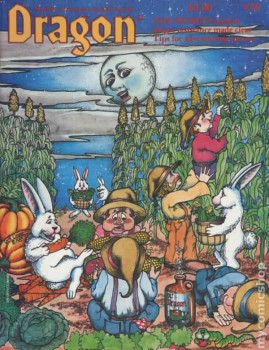 They returned to Wisconsin carrying a large package of samples of my artwork. Not long thereafter, Kim called me and asked me if I would like to try some pen and ink illustrations for Dragon Magazine. I jumped at the chance! From there on I created numerous black and white spot illustrations, six fun Dragon covers, a large full color piece for the 1982 Days of the Dragon Fantasy Art Calendar and a full length short story that I impulsively wrote one night on a friend’s ancient IBM computer, entitled “The Legacy of Hortus“. The story was about a “mad” wizard/horticulturalist who created a cache of bizarre mutated plants. Apparently my affinity for biology never left me. Accompanying that story was the cover for that issue and fifteen spot illustrations.
They returned to Wisconsin carrying a large package of samples of my artwork. Not long thereafter, Kim called me and asked me if I would like to try some pen and ink illustrations for Dragon Magazine. I jumped at the chance! From there on I created numerous black and white spot illustrations, six fun Dragon covers, a large full color piece for the 1982 Days of the Dragon Fantasy Art Calendar and a full length short story that I impulsively wrote one night on a friend’s ancient IBM computer, entitled “The Legacy of Hortus“. The story was about a “mad” wizard/horticulturalist who created a cache of bizarre mutated plants. Apparently my affinity for biology never left me. Accompanying that story was the cover for that issue and fifteen spot illustrations.
There is little doubt that your covers are a divergence from the standard fantasy seen on most issues of Dragon. Was there a reason for this?
I’ve always been a bit of a non-conformist, as is probably the case with most artists and creative types. And I’ve always rejected the “norm”, meaningless rules, and established styles for almost everything. My style of drawing is … my style of drawing … as is the case with most artists. And, when I first started working for Dragon I was unambiguous about insisting that I never create art depicting one human being inflicting death or injury upon another human being … or any other sentient beings. This seems to be a predictable response to having spent four years in the military with one of those years in a war zone. Kim was perfectly comfortable with those parameters.
Kim, his staff, and I had a nice working relationship for the years that I was a contributor to the magazine. But, eventually the country’s obsession with the game waned, their budget suffered, and I moved on to other things. But I will always have fond memories and some great artwork to show for the years working with Dragon and the gang.
You did six classic covers for Dragon starting with Issue # 54 and ending with Issue #96. Of these, do you have a personal favorite?
Probably the very first cover, Tree-Men in the Dismal Swamp. Second would be The Andragon [an android dragon – your personal favorite], followed by the cover and story for The Legacy of Hortus.
Yes, I’ve always been partial to the ‘Andragon’ cover from Issue #96. Can you speak a bit about how this one came about?
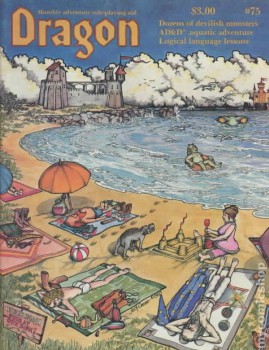 This one was probably a direct result of the two and a half years working in the world of corporate engineering. I have a talent for being able to repair or construct almost anything [which really pays off with the legal displays that I create], a trait inherited from my father, who could take apart and put back together anything! The dog in the art was meant to be my beloved, but long-gone, Labrador Retriever. The individual reviewing the blueprints was meant to be me, sans mustache. The woman at the top of the stairs was my mother.
This one was probably a direct result of the two and a half years working in the world of corporate engineering. I have a talent for being able to repair or construct almost anything [which really pays off with the legal displays that I create], a trait inherited from my father, who could take apart and put back together anything! The dog in the art was meant to be my beloved, but long-gone, Labrador Retriever. The individual reviewing the blueprints was meant to be me, sans mustache. The woman at the top of the stairs was my mother.
Other than covers, were there any other illustrations you did for TSR that fans might not know about?
One of my first assignments was to create multiple pen and ink spot illustrations for a piece entitled The Lure of the Golden Godling which appeared in Volume V, No. 6 in 1980. There were other assorted spot illustrations dispersed throughout the years that I worked for Dragon. One of those was the spot illustration of Gary Gygax in a bathing suit, floating in an inner tube, which, despite all of my efforts, I cannot locate. I know that you’re dying to see that one! Don’t give up. I’m still looking.
Your last cover appeared in April 1985. Where did your career take you after you stopped doing covers for Dragon?
Everywhere! I’ve created covers and spot illustrations for Forum [the official publication for the College of American Physicians]; The Wilmington News Journal; Esquire Magazine; the Philadelphia Inquirer; The Philadelphia Evening Bulletin; Philadelphia Magazine; The Detroit Free Press; Today Magazine; various gardening, craft, medical, educational, university and science magazines too numerous to list; over two dozen major book publishers, and design work for a mix of companies, hospitals and law firms. Also included are dozens of legal displays that frequently involved making detailed three dimensional models. The model making was both challenging, rewarding on many levels, and tremendous fun.
However, I’ve rejected offers to accept positions as either a staff designer or art director for a couple of companies. Didn’t want to be stuck in an office or cubicle… or wear a suit! I cherish my freedom! I also refused to accept work for – creating ads and design work for a major casino; a company that wanted me create tobacco ads [YIPE!]; chemical companies, etc.
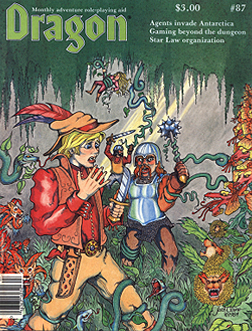 I hate being bored and broke, but I also have unflinching personal ethics and morals. Not that I haven’t made some award winning mistakes in my professional and personal life, but I’ve always tried to learn and grow from them … and not repeat them. However, I’m sort of a Progressive Libertarian when I comes to restricting anyone’s rights to make personal choices in their lives. You want to ruin your health and life by doing stupid things, go right ahead. Just don’t ask for me to help you pay for the damage!
I hate being bored and broke, but I also have unflinching personal ethics and morals. Not that I haven’t made some award winning mistakes in my professional and personal life, but I’ve always tried to learn and grow from them … and not repeat them. However, I’m sort of a Progressive Libertarian when I comes to restricting anyone’s rights to make personal choices in their lives. You want to ruin your health and life by doing stupid things, go right ahead. Just don’t ask for me to help you pay for the damage!
Kim Mohan was the Editor-in-Chief of Dragon during your time with the magazine. Since the magazine had no Art Director during those formative years, can you tell folks a bit about how it was working with Kim?
It was great working with Kim! He was pretty mellow and we devised a very open-ended way for me to create. I would sit around late into the night [sometimes into the early morning] and draw full color, thumbnail sketches that I would send to him. He would select one or two that he liked and I would proceed with full-sized versions for them to use in Dragon.
By the way, one of my friends was the sculptor who created most of the small die-cast figures used as the Dungeons & Dragons game pieces and characters.
Although you don’t currently work in the fantasy industry, is there any chance you might be enticed back for another cover if the opportunity ever presented itself?
I would love to reenter into the fantasy and/or science fiction field! Make me an offer!
Well, I am very, very close to the Art Director over at Gygax Magazine.
This reminds me, I saw the note in Gygax #3, congratulations on the post Scott.
Article wise, very interesting read, I am fortunate owner of at least one Dragon with Jack’s artwork on the cover. Now i must check the internal art.
Tiberius: Thanks for noticing the Gygax gig. I really wasn’t sure how many folks read the letter from the editor at the beginning 🙂 And yes, Jack is great and his Dragon’s are fun to round out any collection because they are so different.
I recognize all of those covers! 75 was always a particular favorite because of the article (by Ed Greenwood?) detailing the Nine Hells.
Joe H: You got it, the Nine Hells Part I was by Greenwood AND had a very early Elmore interior b/w illustration to boot!
Actually, I wanted you to interview the polar vortex. But Jack Crane turned out to be more interesting.
The Polar Vortex never warmed to my attempts at an interview 😉
Great interview! Thanks for this post.
James: Thanks!
I enjoyed those covers, they were a decent break from the usual style.
BTW- #67 has Fedifensor, the dungeon/adventure that started my love affair with the Astral Plane and all things Gith.
TW: You know, its funny that this article isn’t going gangbusters in traffic and yet I’ve had some of the best written responses ever to an article. Anyway, what isn’t to love about the Astral Plane and the Gith?
[…] the cover from Dragon Magazine number 87 by Jack Crane. I looked him up on the interwebs, and found this interview with […]